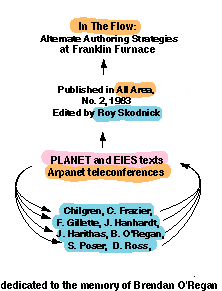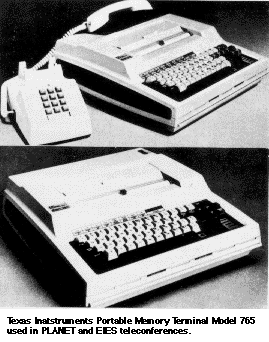

In her book, Life On The Screen (Simon and Schuster 1995), Sherry Turkle emphacizes the emergence of Claude Levi-Strauss' concept of bricolage as a paradigm for computer based interaction:
- The revaluation of bricolage in the culture of simulation includes a new emphasis on visualization and the development of intuition through the manipulation of virtual objects. Instead of having to follow a set of rules laid down in advance, computer users are encouraged to tinker in simulated microworlds. There, they learn about how things work by interacting with them. One can see evidence of this change in the way businesses do their financial planning, archhitects design buildings, and teenagers play with simulation games.(p. 52)
For In The Flow, we are making the results of this ground-breaking early use of networked computers as an artistic authoring tool available for the first time on the world wide web.
The introduction below is excerpted from Scodnik's introduction in All Area. To read the teleconference texts, click a link:
- PLANET Table of Contents
- EIES Table of Contents
- Page 1 PLANET
- Page 1 EIES
- or follow the threaded links which will guide you to sets of entries dealing with particular issues.
Excerpts from From Database to Knowledge Base(click for full text)
Introduction to PLANET and EIES teleconference texts by Roy Skodnick All Area No. 2, 1983.
- These texts were edited from the terminal print-outs
of two teleconferences generated on two different computer conferencing
systems. The first (from November, 1978 to February, 1979) was conducted
on PLANET, the second (from January to May, 1981) on EIES. Both conferences
were intended as forums to consider the possible uses of emerging electronic
technologies in the production, interpretation and distribution of art.
They were expected to develop texts as well as implement design and construction
of museum-related events. Although each conference involved several "players"
in different parts of the country, discussion was principally between artist
Frank Gillette in New York and Brendan O'Regan, Director of Research of
the Institute of Noetic Sciences, in San Francisco. The PLANET conference
also included physician Richard Chilgren in Hawaii, David Ross then Curator
of the University Museum, Univ. of Cal., Berkeley, and the sculptor Charles
Frazier. The EIES conference was sponsored by The Film and Video Department
of the Whitney Museum of American Art and the Institute of Noetic Sciences,
and included John G. Hanhardt, Curator of Film and Video at the Whitney,
James Harithas, former Director of the Everson Museum in Syracuse, New
York, and Steven Poser, a writer (trained in philosophy) who assisted Hanhardt,
in co-ordinating and evaluating the conference.
Each participant used a Texas Instruments Portable Memory Terminal (Silent 700 series) Model 765 which has a 20K memory capacity, i.e., it can store 20,000 bits of information in the memory element of the terminal itself, independent of the memory capacity of the teleconferencing system to which the terminal is linked by telephone through the Telenet system. The terminal allows for composition off-line, followed by rapid transmission from the magnetic "bubble memory" of the terminal through the phone link to the computer for dissemination.
As with most advanced technology, computerized conferencing is a spin-off from developments first used by the government for military and strategic purposes:
'Packet switching' is the use of minicomputers to break data into packets, send them by the fastest available circuits (satellites, microwave, or cable) and then reassemble the packets for the user. The system was developed by ARPA, the Advance Research Projects Agency of the Defense Department which developed a nationwide network of government and research oriented computers from places like M.I.T. and Stanford, and is now available for public commercial use.
- Daniel Bell "Teletext and Technology" The Winding Passage Basic Books, 1977, p41.
ARPANET was de-classified in 1967. The actual design implementation of computerized conferences originates in the Office of Emergency Preparedness (OEP) of the President of the United States. The first computerized system harnessed instantaneous transfer of information to conventional methods of data gathering through questionnaires, a further development of the Delphi system which soon led to "a highly innovative technique for using a computer to structure human communication for information exchange and collective effort to solve a problem." (Murray Turoff and Star Hiltz, The Network Nation, Addison Wesley, 1978., p.49). EMISARI (The Emergency Management Information System and Reference Index) was the first such system; PLANET(developed at the Institute for the Future in Palo Alto, Calif.) and EIES (Electronic Information Exchange System developed by Murray Turoff at the New Jersey Institute of Technology in Newark, New Jersey) are two of the more sophisticated, flexible systems that exist today among several. PLANET and EIES structure communication into several options and modes presented as a "menu." The EIES system
supports electronic messaging, conferencing, personal notebooks, text editing, and document preparation. It includes a multitude of specialized features such as voting, automated questionnaires, and data-gathering...EIES has five alternative human machine interfaces, from simple menus for the beginning and casual user to self-defined user commands and procedures for customized tailoring of the interface.- EIES access statement
PLANET allows participants in public conferences to exchange private one-to-one messages at the same time. Despite elimination of face-to-face cues and other kinds of kinesic context and contact, the "space" of computerized conferencing generates a complex social world with its own evolving norms, another realm of micro-sociology Gillette observes.
The history of these systems is subtly more fugitive than this summary indicates. Murray Turoff was "system designer and programming manager" in the System Evaluation Division (SED) of OEP....Turoff began to collaborate, outside of channels, with Language Systems Development (LSD), a group hired to design software for OEP's computer laboratory:
In 1968 I held a number of meetings with the Language and Systems Development people....Without any formal arrangements between LSD and OEP, I suggested a number of requirements and modifications to their language that would allow for the programming of communication structures, and LSD incorporated this into their design. As a result in late 1969, there was a software capability available to automate a Delphi Process.- Turoff and Hiltz, op.cit.. p.47.
Turoff continued to develop more complex systems:
Problems still existed with the 1108 software, one of which was that they [the OEP computer shop] could not tell who was doing what from any of their remote terminals. This was their problem, our advantage. [ibid. p.47]Eventually the palace guard began to notice:
...the rest of OEP became aware that something was going on. This occurred because the computer console operators began to talk about people from all over the country who would occasionally phone to find out some piece of information about hours and such things. This gradually filtered up the ladder until someone decided to ask what was going on...they discovered that there were a lot of people accessing its computer from outside the organization and doing something with it that had not been programmed by them. They got a bit upset and conducted a complete investigation to see if government resources were being misused. [ibid. p. 48.]At one point Turoff's computer terminal was taken away, but he and his co-workers had allies, including the head of OEP, General Lincoln who was "one of the five statutory members of the National Security Council".
The system proved itself useful and became part of the steering capacity in crisis management and intervention although OEP ceased to exist....The democratic nature of entry and participation in these systems tends to shake up formal hierarchies of management and decision-making. Turoff and Hiltz speculate on the effects computerized conferencing will have on the normative set-ups and paradigm structures of research science. Planning and advocacy groups will no doubt accelerate democratic applications, complicate the steering process, alter research goals, as well as re-configure access to information. Turoff is committed to the design of non-monopoly systems which allow any sender to be an originator of information.
The above is excerpted from "From
Data Base to Knowledge Base" introduction to PLANET and EIES teleconference
texts by Roy Skodnick published in All Area No. 2, 1983, N.Y.C. pp. 68-69.
Click
here to see the complete introduction as well
as a preface by then director of Whitney Film and Video Dept.,John G. Hanhardt.
In addition to the chronological order in which the PLANET and EIES text is presented in the numbered pages, we have created threaded links which will guide readers to related sets of entries pertaining to alternate authoring strategies. To follow a thread, begin at the link icons below and read from the top of the screen to which a link connects until the next icon link in the thread occurs. (Occassionally, the same entry is targeted by more than one thread. Be sure to find and click the appropriate icon to continue following a given thread.)
PLANET THREADS
![]() These icons target entries concerning authorship on-line.
These icons target entries concerning authorship on-line.
![]() These icons target entries concerning the function of metaphor in
the interactive medium of the network especially the metaphor of play.
These icons target entries concerning the function of metaphor in
the interactive medium of the network especially the metaphor of play.
![]() These icons target entries dealing with the accomodation of the body
to mediated interaction.
These icons target entries dealing with the accomodation of the body
to mediated interaction.
EIES THREADS
![]() These icons target entries concerning the concept of the bricoleur
and
expand on the
These icons target entries concerning the concept of the bricoleur
and
expand on the ![]() PLANET thread.
PLANET thread.
![]() These icons target entries relating to authorship on-line.
These icons target entries relating to authorship on-line.